Please view our updated COVID-19 guidelines and visiting procedures →.

Hospice care is a specialized form of healthcare that focuses on enhancing the quality of life for individuals with terminal illnesses. The goal is to provide comfort, support, and dignity during the end-of-life journey. However, the use of medications, particularly benzodiazepines, have been both a blessing and a controversy in end-of-life care. In this blog post, we will explore the role of benzodiazepines in hospice care, the benefits they offer, potential drawbacks, and the ethical considerations surrounding their use.
Benzodiazepines are a class of sedative drugs that act on the central nervous system. They are commonly prescribed to alleviate symptoms such as anxiety, insomnia, and seizures. These medications produce a calming and sedative effect. Examples of benzodiazepines include diazepam (Valium), lorazepam (Ativan), and alprazolam (Xanax). While these medications can be highly effective in managing certain conditions, their use in hospice care requires careful consideration.

The use of benzodiazepines in hospice care requires thoughtful reflection. Key considerations include:
Palliative sedation is a carefully regulated and monitored medical intervention that is employed when other forms of symptom management have proven ineffective. It is typically reserved for patients experiencing severe distress, refractory symptoms, or existential suffering that cannot be alleviated through conventional means. Palliative sedation aims to balance the relief of symptoms with the preservation of patient comfort and dignity. Benzodiazepines, a class of sedative drugs, are frequently employed in palliative sedation due to their effectiveness in promoting a peaceful and comfortable experience for patients nearing end of life.
The use of benzodiazepines for palliative sedation in hospice care is a complex but widely ethically accepted practice. These medications offer effective symptom control and rapid onset of sedation, and their use requires careful consideration of individual patient needs, open communication, and adherence to ethical practice – long a core principal of patient care at Connecticut Hospice. The goal of hospice physicians who employ palliative sedation is always the enhancement of patient comfort and dignity during the final stages of life. By embracing a patient/family-centered, multidisciplinary approach, healthcare professionals can provide compassionate care that honors the values and preferences of those under their charge, ensuring a peaceful and dignified journey toward the end of life.
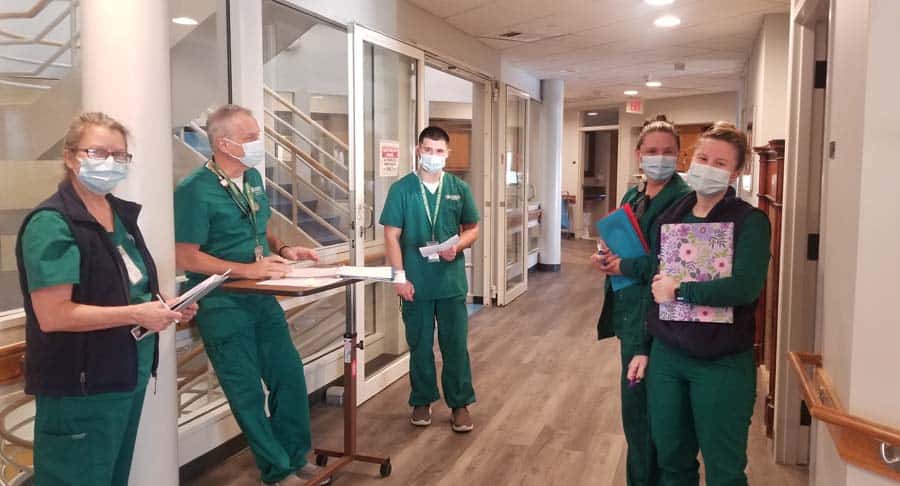
The use of benzodiazepines in hospice care requires careful consideration of medical, ethical, and patient-centered factors by experienced physicians and nurses. These medications offer valuable benefits in managing symptoms associated with terminal illnesses; patients and families may be assured that the healthcare providers at Connecticut Hospice expertly navigate all potential concerns associated with their use. Open communication, informed consent, and regular reassessment are key components of a comprehensive approach to benzodiazepine use in hospice care, ensuring that the patient's final journey is characterized by comfort, dignity, and respect for their autonomy.

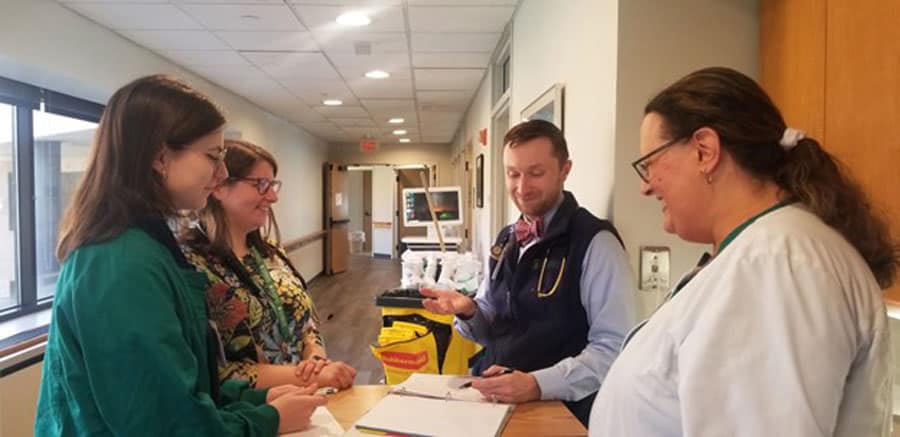
In the ever-evolving landscape of medical education, institutions that prioritize hands-on experience, interdisciplinary collaboration, and compassionate care are invaluable. The Connecticut Hospice stands out as a beacon of excellence, offering a myriad of educational opportunities for pre-med students, medical students, residents, and fellows. This blog post will delve into the educational programs provided by The Connecticut Hospice through the John D. Thomas Institute and shed some light on how they contribute to the development of well-rounded and empathetic healthcare professionals.
Before delving into the educational offerings, it's essential to understand the foundation upon which The Connecticut Hospice stands. Established in 1974, it holds the distinction of being the nation's first hospice. Its mission revolves around providing patient-centered, end-of-life care rooted in compassion, dignity, and respect. This commitment to holistic care forms the backbone of the educational opportunities offered.
The John D. Thompson Hospice Institute for Education, Training and Research, Inc. (JDT Institute), the educational ally of Connecticut Hospice, was established in 1979, when it gave its first educational conference. The JDT Hospice Institute is a vehicle for sharing the hospice philosophy with all who desire to improve the quality of care for patients (and their loved ones) experiencing an irreversible illness. It offers opportunities for students, health care professionals, administrators, caregivers, and the lay community to learn, and gain experience and skills in hospice care.
At the core of good hospice care is the interdisciplinary team approach. Every patient is cared for by a team that includes medicine, nursing, social work, spiritual, bereavement, pharmacy and volunteers. The team ensures the patient receives care at the physical, mental, and/or emotional levels, if and when needed during their journey. Connecticut Hospice offers clinical rotations in medicine, nursing, social work, and pharmacy.
Traditionally the first milestone in the long journey to becoming a practicing healthcare provider is usually shadowing other providers. Here at Branford, we offer extensive shadowing opportunities. Students can observe seasoned healthcare professionals navigating the challenges of end-of-life care, learning not only medical procedures but also the nuances of compassionate communication both in our inpatient unit as well as with our homecare team. Recognizing the importance of early exposure to hospice and palliative care, The Connecticut Hospice offers pre-med programs designed to ignite the interest of aspiring healthcare professionals and expose them to the realities of practicing medicine in our current healthcare system as well as mentor them to the requirements of applying to graduate professional programs.
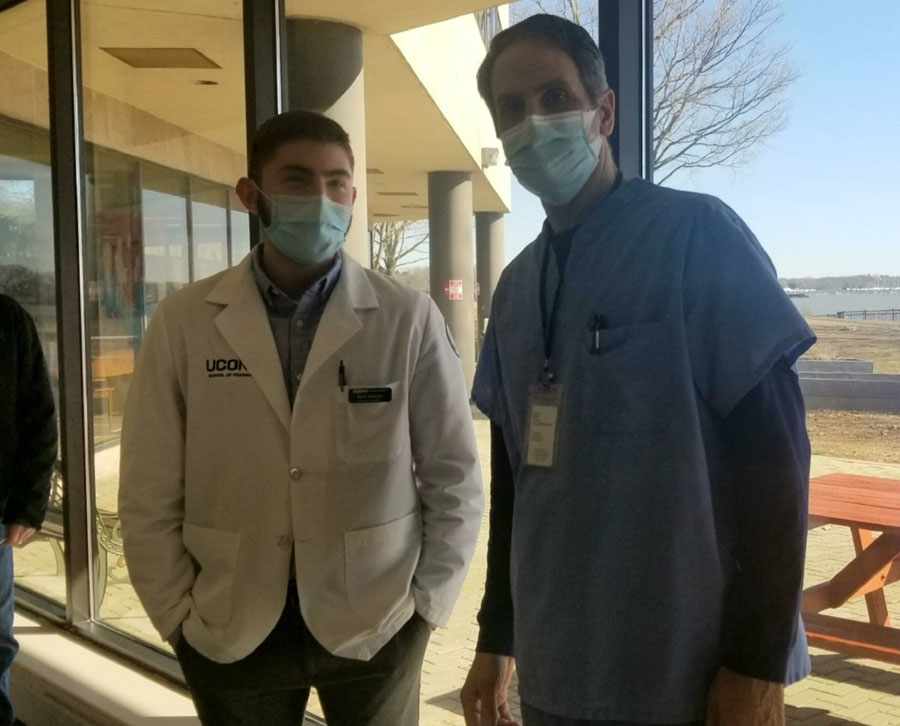
Students approved to complete clinical hours at The Connecticut Hospice are afforded a unique and enriching experience. Although many come from schools in the Northeast, the opportunities to rotate here are open for all institutions across the country. The institution recognizes the importance of exposing future physicians, nurses, social workers, art therapists, music therapists and pharmacists to end-of-life care, fostering empathy, and refining communication skills. Through structured programs, students have the chance to shadow experienced practitioners, and engage in patient care activities under the guidance of experienced mentors. This hands-on experience allows them to apply theoretical knowledge in a real-world setting, honing their clinical skills and deepening their understanding of the unique challenges in end-of-life care.
Throughout COVID, and the nursing shortage, Connecticut Hospice worked with area nursing programs to provide clinical practice hours that were standing in their way of graduating and joining the dwindling nursing pool. Yes, it is about teaching how to provide good hospice and palliative care, but it is also about sharing the importance of both hospice and palliative care in the cycle of terminal illness.
The Connecticut Hospice places a strong emphasis on interdisciplinary collaboration. Learners here actively participate in rounds that bring together physicians, nurses, social workers, and other healthcare professionals. This approach provides a holistic view of patient care, fostering an understanding of the diverse skills required in end-of-life medicine.
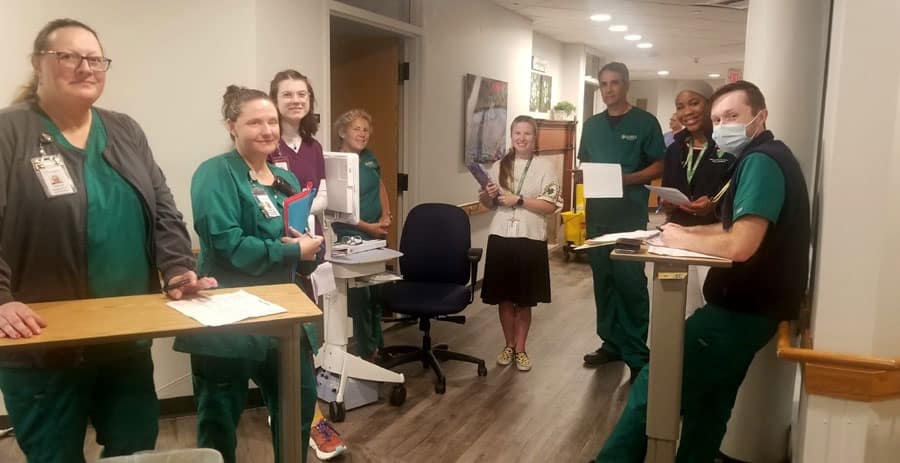
For medical residents seeking to specialize in palliative care or related fields, The Connecticut Hospice offers comprehensive clinical exposure to end of life medicine. Residents may come from any ACGME accredited program and specialty. These programs provide a structured curriculum that combines clinical experience, research opportunities, and mentorship in a variety of inpatient and outpatient settings. Rotating residents at The Connecticut Hospice benefit from a diverse range of clinical experiences. From managing complex symptoms to leading family meetings, residents are actively involved in the care of patients facing life-limiting illnesses. This exposure equips them with the skills necessary for providing compassionate and effective end-of-life care.
Students earning an advanced degree in nursing, social work, art therapy, music therapy or pharmacy spend a significant amount of time at Connecticut Hospice, quickly becoming a member of the care team and gaining unique experiences from collaborating care.
Social Workers pursuing a Masters spend their entire final year with us, allowing them the opportunity to learn from a seasoned social worker how to best guide a patient and their family through one of the most stressful events of life, death of a loved one. There are so many factors to consider when caring for a family unit, especially when death is at the core. It takes time for a social worker to become comfortable with the unique needs of a hospice population and the extended time allows for learning and experiencing from the seasoned social worker.

The JDT institution encourages learners across the spectrum of academia to engage in research projects that contribute to the evolving field of palliative care. By collaborating with experienced researchers and faculty members here at the Connecticut Hospice, learners get the opportunity to explore innovative approaches to symptom management, psychosocial support, and ethical considerations in end-of-life care and receiving the structured mentorship to pursue their own individual projects.
Every PharmD candidate who completes a month-long rotation with Connecticut Hospice’s onsite Pharmacy Department is required to present findings on a pharmacological topic selected prior to the start of their rotation. The findings are presented on the student’s final day to members of the interdisciplinary team who were all part of the learning experience. The collaboration between a student and those with heavy experience can create something great.
Mentorship plays a pivotal role in the residency programs at The Connecticut Hospice. Our learners work closely with our seasoned professionals who provide guidance not only in clinical matters but also in navigating the emotional and ethical dimensions of palliative care, as well as preparing for the next step in their own professional journeys.
If clinical medicine isn’t desired, The Connecticut Hospice also can offer unique individualized internships with our senior management and executive teams. Rotating through our non-profit and working directly with our executives provides the learner with a special opportunity to collaborate closely on business development plans and network with regional partners.
The Connecticut Hospice's offers tailored programs and educational workshops that cover the basics of palliative care, hospice care, pain management, and the psychosocial aspects of end-of-life care. These workshops serve as a bridge between classroom learning and practical application in the community. We offer these experiences and lectures to our community partners and travel to them to deliver these interactive and informative sessions.
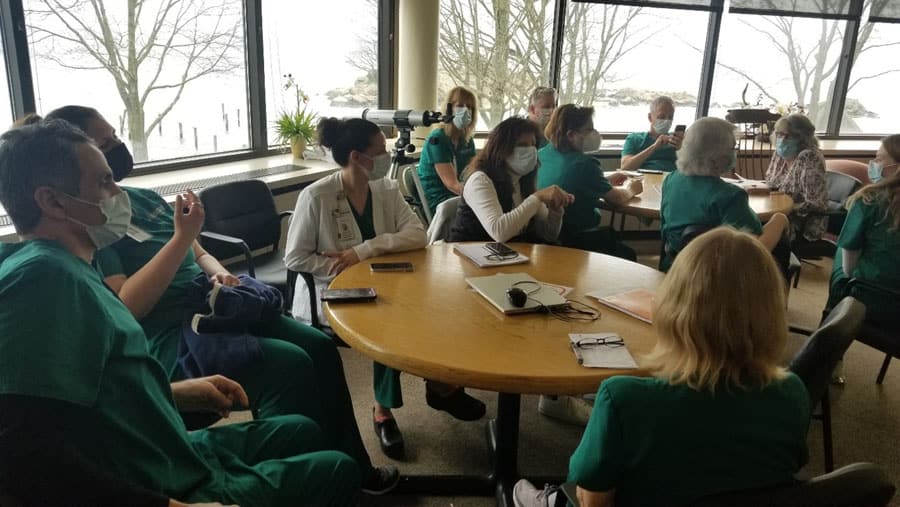
In addition to the above, The Connecticut Hospice offers a robust and enriching volunteer experience. These hands-on experiences allow each person to donate their time and/or talent to our patients in a multitude of ways. Each new academic year provides Connecticut Hospice with more than 75 medical students looking to volunteer to gain experience working with patients and families. These future healthcare providers create a positive energy that fills the building. In addition to these medical students, Connecticut Hospice is always in need of volunteers to share their talents with us. If you or your organization is interested in volunteering, please reach out to our Director of Volunteers at [email protected].

The educational opportunities offered by The Connecticut Hospice form a critical component of the institution's commitment to advancing the field of hospice and palliative care. No matter what a student’s ultimate position is in healthcare, Connecticut Hospice encourages them to take the unique experiences offered at America’s first hospice to enable them to be the best they can be throughout their career. By combining hands-on experiences, interdisciplinary collaboration, and a commitment to compassionate care, The Connecticut Hospice is shaping the next generation of healthcare professionals who will navigate the complexities of end-of-life medicine with skill, empathy, and resilience. As we look toward the future of healthcare, the lessons learned at The Connecticut Hospice serve as a guiding light for those dedicated to providing dignified and compassionate end-of-life care.
For more information on clinical rotations at Connecticut Hospice, email [email protected].
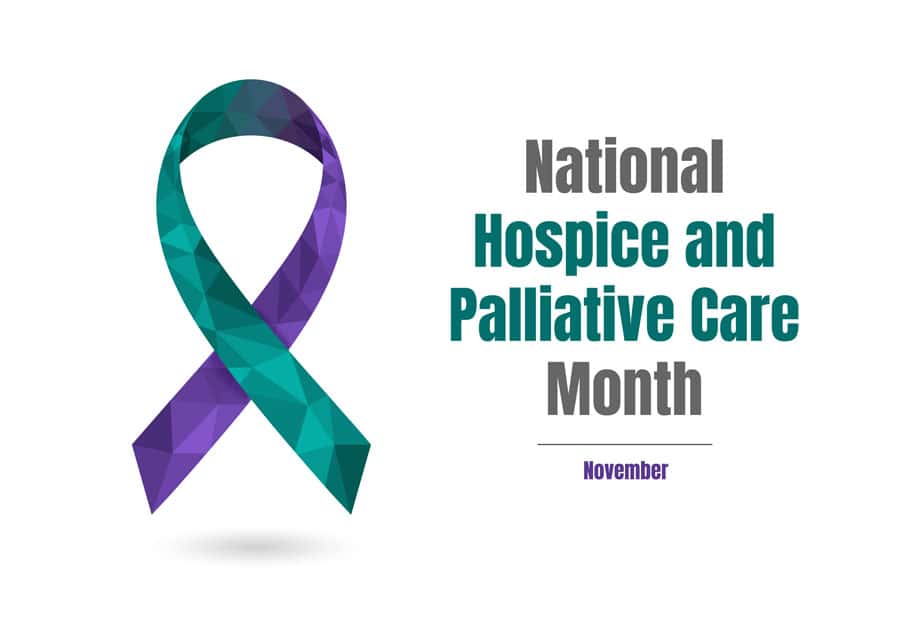
Announced in 1978 by then President Jimmy Carter, the month was established to recognize the efforts of those who provide end-of-life care, and to help raise awareness of the growing hospice movement. By the time of this designation, Connecticut Hospice, America’s first, had already been providing high-quality care to hospice patients for 5 years.
We have come a long way since 1978. President Carter is now a hospice patient. Hospice is well-established in the United States and around the world; 1.7 million American Medicare beneficiaries will avail themselves of hospice care in 2023.
Ironically, despite this progress, most people do not know the difference between hospice and palliative care. So, in honor of National Hospice and Palliative Care Month, this blog will be a primer on two very distinct medical specialties.
Hospice is a benefit -- an entitlement, like Social Security, provided by Uncle Sam -- available to people whom a physician estimates to have six months or less to live if their illness progresses through its natural course and who have declined further treatment in favor of focusing on the quality of the life they have remaining. Most hospice programs are financed by Medicare – at no cost to patients -- though many other insurers, including Medicaid, offer hospice benefits. All hospices must provide a specific set of services to the patients they enroll, including skilled nursing and medical services, social work, chaplaincy, volunteer, and other professional services.


While both hospice and palliative care are part of the same medical specialty, complete with post-residency fellowships and, since 2006, board certification, palliative care is distinct from hospice. Appropriate for all people with serious illness, including those still seeking treatment of their disease -- an important distinction from hospice -- palliative care helps patients and their loved ones understand the condition, treatment options, and likely disease trajectory so they may make informed choices that align with their goals and wishes. It also provides expert management of symptoms such as pain, shortness of breath, and nausea, helps people obtain non-medical assistance like help in the home, and may even provide medical management of the disease and its complications.
I had the privilege of providing palliative care to two patients who exemplify the specialty at its best. One, a woman in her fifties, was diagnosed with a malignancy and referred to a home palliative care program I worked with. She was suffering from pain and anxiety, and the nurses, social workers and I collaborated to provide her relief from these symptoms with counseling, support, and medications. Literate, educated, and a self-starter, she then set about finding a leading physician to offer treatment for her disease.
When she returned from her first appointment she was confused.
“What did he say?” I asked during a home visit.
“I didn't understand a word of it,” she told me, exasperated. “I’m not even sure he was speaking English.”
This was not at all uncommon. Though well-intended, doctors often struggle to make medical information understandable for their patients, who typically do not have medical training. Palliative care doctors specialize in exactly this kind of conversation.
“Would you like me to call him and find out what he can do for you and let you know?” I asked.
She did. I returned to her home a few days later and got straight to the point, cutting through the medical esoterica that had characterized my discussion with the surgeon -- and, apparently, what he had told her. “The surgeon said you have a better than 80% chance of being cured with an operation,” I told her.
“Would you do it?” she asked.
“Those are pretty good odds,” I said. “I'd go for it.”
That was more than five years ago. I still get Christmas cards from her. Cured, she returned to her life and no longer needs palliative care.
The second was a man in his late 60s. Retired, he had recently lost his beloved wife, and suffered from advanced cancer that left him fatigued and mostly unable to get up from the couch in his living room. He'd been suffering from cancer for 10 years; his oncologist had managed again and again to find a treatment to prolong his life.
He had thought about his condition and was direct about his wishes. “So long as my doctor can keep my cancer in check,” he said, “I'm going to keep getting treated. But when it stops working, I'm going to enroll in hospice so I can die in comfort.”
I was impressed. “What do you like to do?” I asked. “For fun?”
“Fish,” he said without hesitation. “Trout. Catch and release. I even have a blog. But I'm too tired for that now,” he said with a resigned frown. “I can barely get off this couch.”
I had some tricks up my sleeve. I started him on a brief course of high dose corticosteroids and amphetamine. He virtually leapt from his couch, donned his floppy fishing hat and khaki vest, festooned with flies he had tied himself, climbed into his pickup truck, picked up his son, and spent a day catching trout and throwing them back into one of his favorite fishing spots.
I stopped the medications and he flopped back on his couch. Six months later he was admitted to our inpatient hospice facility. Treatment was no longer holding back his cancer and he had worsening shortness of breath.
I stopped in at his bedside on the morning of his admission. “How can we help?” I asked.
He answered with his characteristic lack of hesitation. “I want to stop feeling short of breath, I want to see my son get married, and I want to die in peace,” he replied.
His son stood on the opposite side of the bed. “When are you getting married?” I asked him.
“In three months,” he replied.
Later, we spoke in the hall. “You're getting married tomorrow at your dad's bedside,” I said.
“I think you misunderstood doc,” he said. “I'm getting married in three months.”
“I understood,” I said, “but I'm asking you to get married tomorrow at your dad's bedside.”
He and his fiancé married the following day in a ceremony attended by most of the hospice staff. He wore a tuxedo and she a wedding gown. There was music, dancing and champagne – right in his father’s room. His father could not stop smiling. He died peacefully the following day.

Connecticut Hospice is proud to launch a palliative care program, which will be fully operational in December. Our APRN, social workers, and chaplaincy will be offering palliative care to patients who are self-referred, or referred by friends, family, or by their doctors. We will see patients in a brand-new clinic in our inpatient facility in Branford, by telehealth, and in people's homes or in skilled nursing, assisted living, or independent living facilities.
For more information about our new palliative care program, call 203-315-7540.

No matter your age or health status, a properly executed Advance Directive is essential to assure you receive healthcare that aligns with your beliefs and wishes. Even the young and healthy may find themselves in an unanticipated medical situation in which an Advance Directive is critical.
An Advance Directive is a legal document that allows you to maintain control over the healthcare you receive should you be in a circumstance where you are unable to communicate your wishes to your healthcare providers.
Which Advance Directive to choose depends on your wishes, your understanding of the limitations of each type of Advance Directive, and your state of health. First, let’s review the healthcare representative. Before we do, though, some confusion about this form of Advance Directive needs to be cleared up. In addition to the term “healthcare representative,” you may also hear the phrases “healthcare agent,” and “durable power of attorney for healthcare.” Each of these is essentially the same, and Connecticut officially replaced the latter two terms with the former on October 1, 2006. In keeping with this, I will use “healthcare representative” going forward to refer to this form of Advance Directive.
A healthcare representative is legally designated by an individual to make their healthcare decisions should they no longer be able to communicate — for example, they are unconscious and cannot talk or write. In contrast to the other types of Advance Directive, a healthcare representative offers the most flexibility in directing doctors and other healthcare workers no matter the now-incapacitated person’s medical circumstance. A Living Will cannot be honored unless specific criteria are met and may not allow medical providers reasonable flexibility in the care they provide (discussed below). A Connecticut MOLST is also very specific, and is only legally used for people with serious illness (also discussed below).
Designating a healthcare representative is easy and does not require a lawyer or Notary Public. Your healthcare representative should be a person — many people designate a good friend -- who will follow your wishes for care with a lesser likelihood of being so emotionally involved as to find it difficult to do as you have instructed – such as a wrenching decision to discontinue life support. This is one reason why a friend may be a better healthcare representative than a close – and more emotionally involved -- family member such as a spouse, parent, or child.
Once you have decided who to designate as your healthcare representative – and once they have agreed to take on this important role (an alternate representative may also be designated should your primary representative be unavailable or decline to make decisions), it is imperative to have a conversation with them about what your wishes would be in a variety of circumstances. For example, some people may want more aggressive care should they become ill with a life-threatening though potentially curable illness than they would if they had a terminal illness with few treatment options and a lesser likelihood of recovery. However, it is impossible to anticipate all medical eventualities— I have tried— and one advantage of the healthcare representative is that he or she has freer rein to direct care in the spirit of your wishes – regardless of your exact medical circumstance -- than is allowed by a living will or MOLST.
To complete your legally enforceable healthcare representative paperwork, which requires two witnesses but again does not require a lawyer or a Notary Public, download a detailed PDF outlining Advance Directive procedure in Connecticut (including healthcare representative, Conservator of the Person, living will, and anatomic donations. MOLST cannot be completed with an online form – see below).
It is worth noting that you must be able to understand the consequences of your decisions to designate a healthcare representative. People who are significantly cognitively impaired, from dementia, for example, and are unable to direct a healthcare representative sensibly and reasonably, are not eligible. Likewise, someone with impaired consciousness is also not eligible. This is why it is important to choose one before becoming seriously ill.
For the sake of completeness, if you designated a durable power of attorney for healthcare in Connecticut before October 1, 2006, that person has the same medical decision-making rights as a healthcare representative. If you designated a healthcare agent – not a representative -- prior to October 1, 2006, that person may only make decisions about withdrawing or withholding life support, not all healthcare decisions. And if you don’t have a legal Advance Directive in Connecticut, healthcare providers will look to your next of kin for decisions. In order of preference, these are your spouse, adult child, and parent -- or other relatives if they are not available.

All in all, and especially considering the difficulty healthcare providers will have following instructions if family members disagree about the care you should receive, these factors make it clear that it makes far more sense to simply designate an up-to-date healthcare representative and to do it now.
A Connecticut “Conservator of the Person” is an individual, often a lawyer, appointed by a Probate Court and responsible for healthcare decisions for someone who is permanently unable to care for, and communicate their healthcare decisions – such as someone with dementia. Usually, Conservators are assigned to people who have not designated a healthcare representative and are no longer capable of doing so. While a Conservator is empowered to make all healthcare decisions, their role usually relates to custodial needs— such as admission to a nursing home— although they may also make decisions about specific medical interventions. If someone with a court-appointed conservator already has healthcare representative, having designated one while they were still able, the decisions of the healthcare representative about day-to-day medical care have more authority than those of the Conservator, unless the Probate Court disagrees.
These instructions require no further input from you, a healthcare representative, a Conservator, or anyone else to be followed by healthcare providers. The Connecticut Living Will provides instructions about your wishes regarding cardiopulmonary resuscitation—or CPR — mechanical ventilation (such as a respirator), artificial nutrition and hydration, (such as tube feeding), and any other specific medical requests you may choose (such as intravenous antibiotics). The Living Will, however, is very specific as to the medical circumstances in which healthcare providers can follow its directives. These include suffering from a terminal illness, permanent unconsciousness, permanent coma, or persistent vegetative state. One potential problem with the Living Will is that reasonable people may disagree on the definition of these entities. One medical provider may believe a condition is terminal, while another may feel that there are still medical treatment options. Likewise, there may be disagreement as to whether a state of unconsciousness or coma is permanent, and how exactly to define “persistent vegetative state.” Recent research in people believed to have no conscious awareness of their surroundings— part of the definition of persistent vegetative state— has shown that some patients may have more awareness than others. This may complicate matters should there be disagreement as to whether you are in persistent vegetative state. I have seen more than one situation in which it was clear that a grievously ill patient would have wanted to be taken off life support but the wording of their living will tied the hands of their healthcare providers. A healthcare representative, on the other hand, can make decisions regardless of these uncertainties, although they should not stray too broadly from your expressed wishes. For example, someone might instruct their healthcare representative to decline further medical interventions – or to stop life support -- should the likelihood of their being indefinitely and seriously neurologically impaired be high, regardless of whether they are terminally ill, “permanently” unconscious, or suffering what may or may not be persistent vegetative state. This decision is up to each individual, and is important to convey to a healthcare representative.
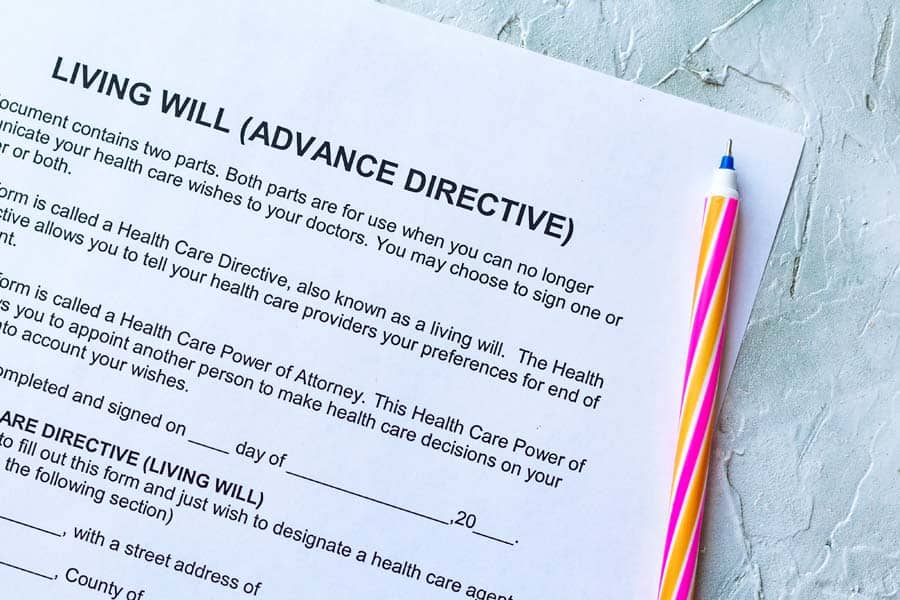
Technically, MOLST is not an Advanced Directive because it specifies the medical treatment that is desired at the time the form is complete, not at some imaginary future time under some unknown medical circumstance. MOLST requires the presence of an “end stage, serious, life limiting illness” or an “advanced chronic progressive frailty condition,” is usually completed by people at significant risk of hospitalization with the risk of death in the very near future, and is very specific as to desired interventions, such as different kinds of ventilator support, ICU care, IV fluid and nutrition, and others. MOLST requires the signature of and counseling by a MOLST trained and certified physician, advanced practice registered nurse (APRN), or physician assistant, and the original lime-green form must be presented for it to be valid. More information about MOLST.
Again, a valid MOLST requires you be counseled by a trained and certified MD, DO, APRN, or PA, and have a signed, original lime green MOLST form. Counseling is imperative -- I have more than once seen incorrectly completed MOLST forms – requesting, for example, both comfort-measures only and life support – unnecessarily complicate care.
The bottom line? At the very minimum, if you are able to read and understand this blog, get to work on designating your legal healthcare representative right now.

When it comes to managing pain and shortness of breath at the end-of-life, opioids play a crucial role in providing comfort and relief. Like a fruit basket that offers a variety of flavors and textures, opioids also come in different forms, each with its unique properties and uses. In this blog post, we'll delve into the differences between two commonly prescribed opioids: morphine and Dilaudid (hydromorphone). These two opioids are most commonly used because when swallowing becomes difficult, they can be injected through an IV or under the skin, whereas some other opioids cannot.

Morphine: The Versatile and Widely Used Fruit
No fruit basket is complete without an apple, and in this analogy, that's morphine! Morphine is among the most well-known and widely used opioids for managing pain, especially in end-of-life care. It is also the oldest, original opioid. It is derived from the poppy plant. Morphine is highly effective in addressing various types and intensities of pain, making it the go-to option for many healthcare providers because, like the apple, it comes in a vast array of preformulated compounds, administration routes, and the dosage can be tailored specifically to the patient’s individual needs. Due to its long-standing presence and extensive research, morphine is well-understood and has established dosing guidelines, making it a reliable choice for pain management and breathlessness.
Dilaudid: The Specialized Fruit for Patients with Kidney Damage
Now, let's shift our attention to Dilaudid, a distinctive fruit in the opioid fruit basket. Think of Dilaudid as a juicy, tropical mango with a unique flavor and texture that caters to specific needs. Dilaudid, or hydromorphone, is a potent opioid analgesic that provides powerful pain relief, particularly for patients with kidney damage. In patients with impaired kidney function, the body may struggle to eliminate or metabolize certain drugs effectively, including morphine. Here's where Dilaudid steps in as a suitable alternative. Dilaudid undergoes a different metabolic pathway, making it less dependent on kidney function for elimination. This characteristic allows healthcare providers to choose Dilaudid for patients experiencing severe pain or for those with renal insufficiency. Its potency makes it effective in smaller doses compared to morphine which is why it is also sometimes a preferred choice.

Opioids: Other Fruit in the Basket
Although we covered the two most frequently used opioids, it is worth mentioning that in addition to these, there are many other different classes of opioids a healthcare provider can choose from. Some well-known ones are Oxycodone, Methadone, Fentanyl, Codeine, and Hydrocodone, to name a few. These each have unique properties that may influence whether they are preferred over morphine or Dilaudid (hydromorphone). In particular, Methadone and Fentanyl are compounded to be potent, long-acting opioids, which means their effects can last days. Fentanyl can even be used as a patch on the skin and is especially helpful if patients need consistent opioids to manage their symptoms but are having difficulty swallowing. Use of these medications are tailored to the specific opioid needs of the patient and usually are started after a short-acting opioid like morphine, oxycodone, hydrocodone, or hydromorphone is already in use.
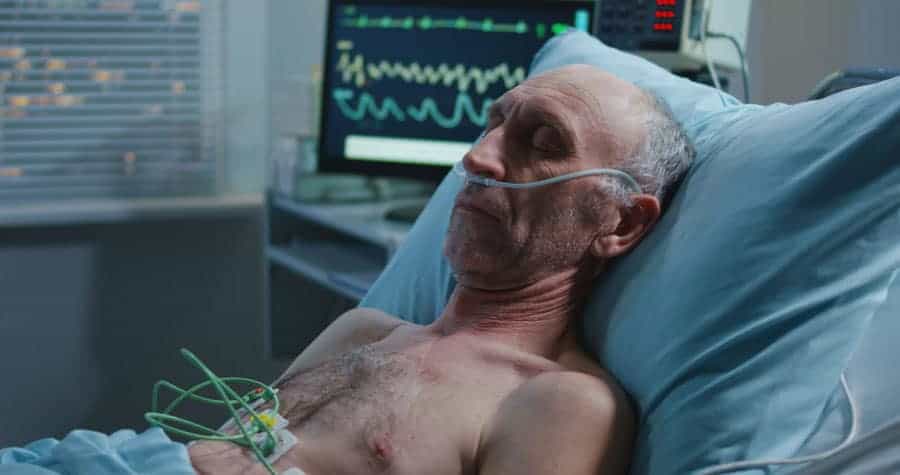
One crucial consideration in end-of-life care is striking the delicate balance between alertness and the relief of suffering. Patients and their loved ones often desire pain relief, but they also want to remain awake and engaged with their loved ones during their final moments. In the community, there is a widely held belief that opioids cause excessive sedation. Although it is true that some people are more sensitive to the sedative effects of opioids (especially if they have never been on an opioid before), the science has actually proven that this drowsiness effect usually improves after several days of consistent opioid use. Unfortunately, many patients arrive at hospice within their final days and believe this excessive drowsiness is due to the opioids when it is much more likely driven by disease progression instead.
It is again worth reiterating that although opioids are very good at relieving most types of pain, they are also equally used at relieving shortness of breath. This may be especially important for patients and their families if the patient has an illness affecting their lung function. Often at the end-of-life, the body’s weakness or disease progression causes it to be much harder for the patient to take regular deep breaths. This could lead to the sensation of “air hunger,” which can cause quite a bit of anxiety for patients and loved ones alike. Opioids work to keep breathing calm and level and greatly help to reduce this potentially frightening sensation.
At some point in the journey, the patient’s family or designated person might have to collaborate with the healthcare provider on the balance of using opioids and other powerful comfort medications to relieve suffering at the cost of alertness. It is crucial to openly discuss pain management goals, preferences, and concerns with healthcare providers. Patients, if able, should actively participate in the decision-making process, ensuring their unique needs are considered by the providers as well as their loved ones before they lose the opportunity to say their wishes. If they are unable to engage in these discussions, then their designated person should make these goals based on what they feel the patient would want and what’s in their best interest. By establishing an open line of communication, patients and healthcare professionals can work together to find the perfect balance of pain relief and alertness and ultimately enhance the patient's end-of-life experience.

Choosing the Right Fruit: Collaborating with Healthcare Providers
Just as different fruits cater to various tastes and dietary needs, selecting the appropriate opioid for end-of-life pain management requires careful consideration and collaboration between healthcare providers and patients. When making decisions about pain management, healthcare professionals consider multiple factors, including the patient's pain intensity, overall health, medical history, and potential drug interactions. In some cases, other opioids like fentanyl, methadone, or oxycodone might also be considered.
Remember, pain management decisions should always be made in consultation with healthcare professionals who possess the knowledge and expertise to provide individualized care. By working together, patients and healthcare providers can find the most suitable opioid, ensuring that end-of-life pain is minimized and comfort is maximized. Just as the fruit basket presents a variety of options, so too do the opioids, providing choices for tailored pain relief during life's final stages.

Our 52-bed inpatient facility on the waterfront in Branford is perhaps the most distinctive feature of The Connecticut Hospice, Inc. This facility affords gorgeous views of Branford Harbor and Long Island Sound, giving our patients and their families access to an outdoor space without compare - barbeques and picnics around patients’ beds with multiple family members and friends in attendance are a common summer sight (once, a patient’s horse even came to visit).
Our inpatient hospice facility also provides the kind of up-to-date symptom management techniques that typically cannot be provided in the home setting. This includes injected pain medications, IV fluids, and other “hospital-like” procedures provided to improve quality-of-life in people with terminal and life-threatening illness. (Note - such interventions are not provided to prolong life. For example, we would not provide IV fluid to an unconscious patient who is very close to the death.)
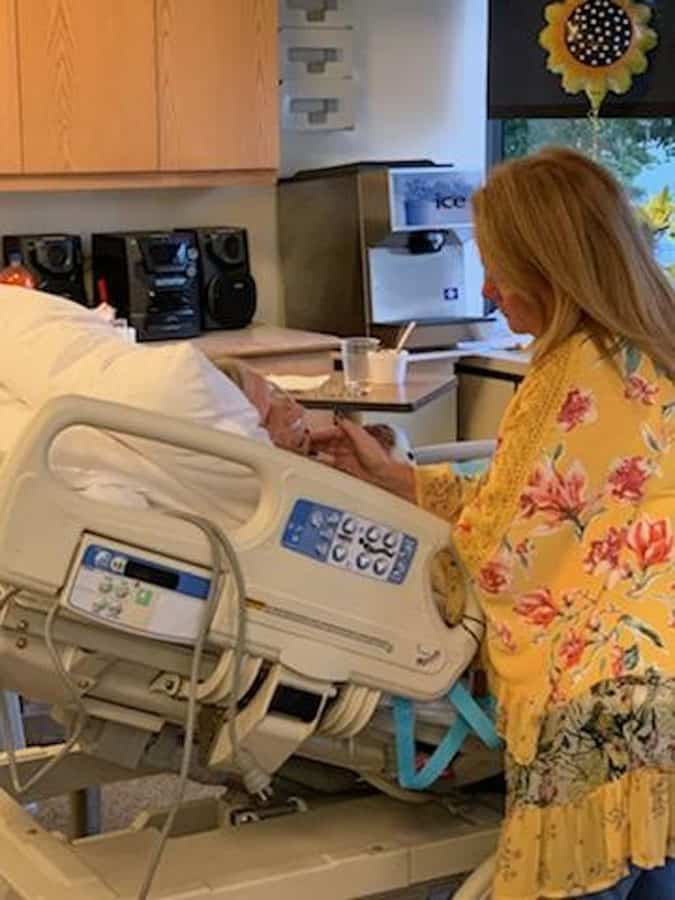
“Having to tell people they are not eligible is the worst part of my job, and I dread it.”
- Joseph Sacco - Chief Medical Officer at The Connecticut Hospice, Inc
Unsurprisingly, the lovely setting and excellent care make admission to Branford a common request, both for hospitalized people who have decided to enroll in hospice and for those in our home care program seeking a higher level of care. It is a request we wish we could grant for all – but can’t. Hopefully, this post will clarify who is and is not eligible for inpatient hospice care and help avoid disappointment among people who thought it was open to all.
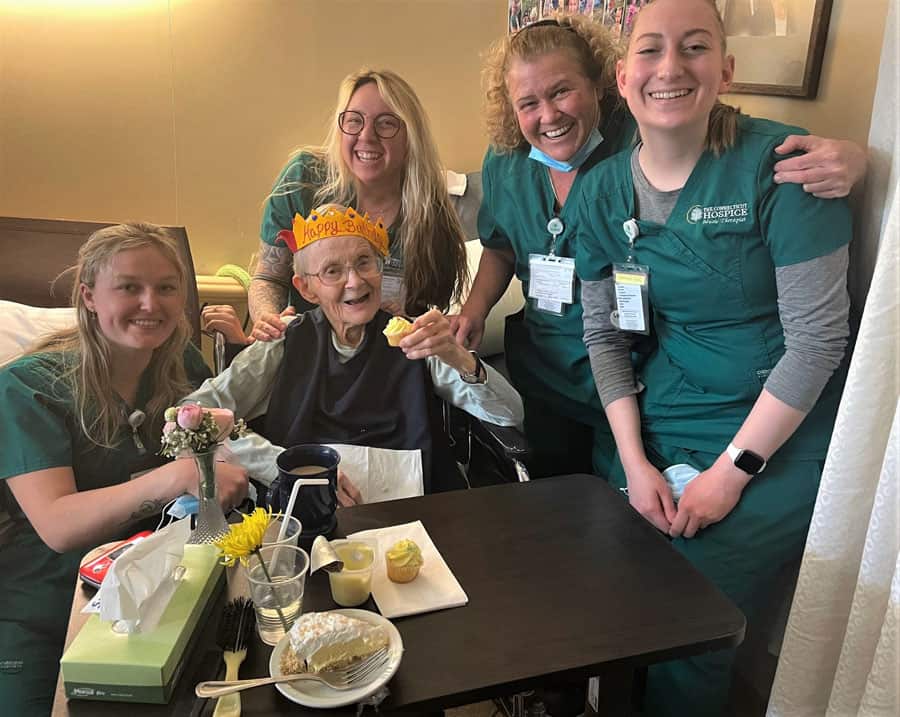
This is the level of care provided for hospice patients who are at home or in a nursing home.
Respite-level care includes five days of admission to our Branford facility (many hospice organizations provide respite care in nursing homes) where care will be provided by our nurses and other staff, allowing family members to rest (some go on a quick 5-day vacation or attend to tasks they’ve had to neglect to care for their loved one).
This is 24/7 care at a patient’s bedside at home, usually provided by a nursing aide. It is only provided for a limited time – generally two days at most – at the very end of life, for patients needing intensive symptom management. Not every patient is eligible, and staff may not be available for an entire 24-hour period.
(General inpatient care, or “GIP”): Hospital-based care, with 24/7 availability of skilled nursing, 7-day/week daytime availability of an MD, DO, APRN, or PA, and 24/7 medical oversight.

Before getting into the details of eligibility for inpatient care, however, let us first make clear that these criteria are a requirement of Medicare, not of The Connecticut Hospice, Inc., and are imposed on all hospice organizations across the country. We truly wish we could provide inpatient care for all of our patients without limitation. Facing serious and terminal illness would seem qualification enough to receive the excellent care offered not only at home but in our lovely waterfront Branford hospital; unfortunately, Medicare does not agree.
The easiest way to determine whether your loved one might be eligible for inpatient care is to ask this question: Must my loved one be cared for in a hospital setting, where skilled nursing care and medical oversight is available 24/7? Or can their care feasibly be managed at home?
Remember that even people who are unconscious but restless, agitated, grimacing, crying out or showing other signs of distress can often be provided successful symptom relief with highly concentrated oral formulations of medications such as morphine or lorazepam put under the tongue, or “transdermal” medications in patch form, such as fentanyl, that do not have to be swallowed to be effective. If these medications have been tried – and Medicare often audits our records for proof that they have – and the only means of providing relief is by injected medications, this would reasonably be considered care that is not feasible at home, and inpatient care would be appropriate.
Wounds that are large and deep, those involving bone or with excessive slough (dead, discolored tissue) or that are obviously infected (I see no need to be graphic, most people are able to tell if a wound is badly infected) may be eligible for inpatient care. There is a caveat, though; wound care in the inpatient setting is not indefinite, and most wounds in hospice care patients do not improve. Once a wound care plan is in place and shown to be adequate to a patient’s needs, we will generally discharge our patient to a lesser setting, where the care will continue to be provided by our home care team in collaboration with family members, or in a nursing home.
“Delirium” is a medical condition characterized by waxing and waning level of consciousness – your loved one may be asleep one moment and climbing out of bed the next -- confusion, short term memory loss, and agitation/restlessness resulting from altered body chemistry in serious illness. It is often seen as people approach the end of life. As with other symptoms, it can sometimes be controlled with oral or under-the-tongue (“sublingual”) medicines. As with other symptoms, Medicare requires that a good faith effort be made to manage delirium at home – if this does not succeed, inpatient care may be an option.
“Sundown syndrome” is characterized by agitation, confusion, and restlessness in elders with dementia that begins when the sun goes down and it gets dark outside. Managing sundown syndrome is hit or miss – medications given at home that work for one elder (such as a sedative like lorazepam – which can sometimes cause a paradoxical increase in agitation -- or an antipsychotic medication like haloperidol or quetiapine) may not help with another. As with delirium, sundown syndrome that cannot be managed at home may be a reason for inpatient admission.
It is understandable that family members of a very sick loved one who have been providing care 24/7 become exhausted and need a break. Unfortunately, this does not qualify their loved one for inpatient admission. The good news, however, is that they will likely be eligible for respite level of care. Generally speaking, patients receiving respite care are relatively stable – which is not to say they do not have a serious illness – take their usual meds, are able to eat, do not need injected medications, and are discharged home after 5 days
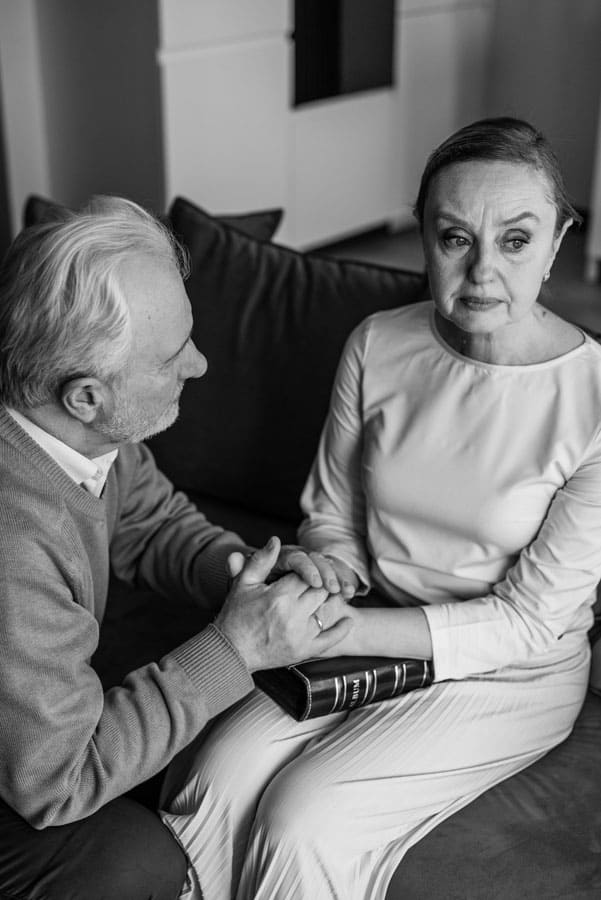
It is understandable that family members of a very sick loved one who have been providing care 24/7 become exhausted and need a break. Unfortunately, this does not qualify their loved one for inpatient admission. The good news, however, is that they will likely be eligible for respite care.
Generally speaking, patients receiving respite care are relatively stable – which is not to say they do not have a serious illness – take their usual meds, are able to eat, do not need injected medications, and are discharged home after 5 days
You may be shocked to learn that imminent death – death expected in hours or days – is not a qualification for inpatient admission, most people are. Medicare insists, however, that the criteria outlined above must be met – for example, symptoms of pain or shortness of breath require injected medications for relief – to admit a patient who is at the very end of life. Most patients in hospice die at home. The good news is that our home care nurses are available 24/7 to help families caring for dying patients at home.
You may also find A Compliance Guide to Inpatient Hospice Care provided by the National Hospice and Palliative Care Organization (NHPCO) to be helpful.
As a not-for-profit, we depend on generous donors to help us provide customized services and therapies that aren’t completely covered by Medicaid, Medicare, or private insurance.
Please make a gift to help us sustain the highest standard of care.
Admissions may be scheduled seven days a week.
Call our Centralized Intake Department: (203) 315-7540.